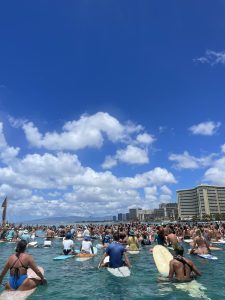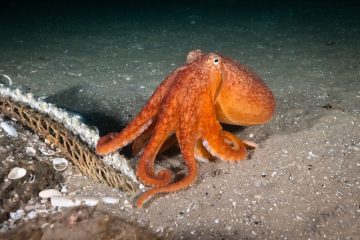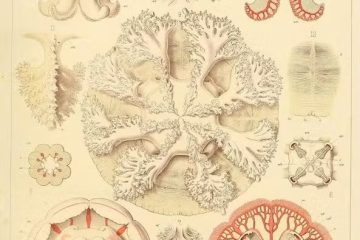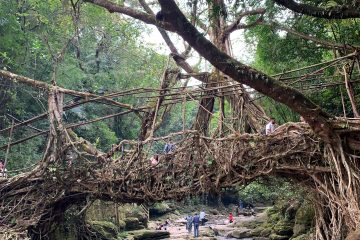We Should All Learn kōkua and kāko‘o

On Wednesday, 9 August 2023, Hawai‘i wakes up to devastating videos of Lahaina going up in flames and images of complete annihilation—houses, cars, and people—from uncontrollable flames driven by strong winds on dry land. The power and phone network is down, making it impossible to reach ‘ohana, family, and friends in West Maui, and leaving Hawai‘i’s people desperate to know who is still alive and what is going on.
Although the Hawaiian community is in incredible shock, they do not remain idle. Instead, they immediately come together to support, assist, and help, those who have lost everything: Donations are collected on all the islands and shipped to Maui; private boat initiatives land on West Maui shores, where inaccessible roads make it difficult to distribute goods; “Kānaka Costcos” are set up to organize donations; Google spreadsheets are created where people can list their missing in hopes that someone will know where they are; other Google spreadsheets are created that list shelters for the now homeless, and organize donations by listing the Venmo accounts of affected families and individuals. Later, many collective pule, prayers, and other events, such as paddle outs, take place channeling mana, power and energy, to and for Laihana; trauma centers emerge, connecting to the cultural practices and belief systems of Kānaka Maoli, Native Hawaiians. Although the Hawaiian community is in incredible shock, they do not freeze in shock, but act because of and with that shock.
I was on O‘ahu during the West Maui fires. Some of my friends there have family ties to Lahaina, yet I am well aware that I am only a temporary member of the Hawaiian community and am barely just beginning to grasp Hawai‘i’s cultural complexity. I chose to write about the fires because in their wake I witnessed what seems to be a key concept in a Hawaiian or rather Kānaka Maoli praxeology in action: kōkua, “to help, assist, support, accommodate, second a motion,” or also kāko‘o, “to uphold, support, favor, assist, prop up; to bind, as with a sash or belt.”
In an interview with me before the fires, kumu hula, hula teacher, Roselle Keli‘ihonipua Bailey, Kanaka Maoli from Lahaina, refers to kōkua as one of the fundamental Hawaiian ethics. To her, kōkua stands for “help without expectations,” to “give without strings attached.” Roselle Keli‘ihonipua Bailey says, “Hawaiians never gave back, once they gave you something it’s yours,” and adds, “Go and help, don’t ask, you just help, that’s kōkua.”
It seems, however, that kōkua or kāko‘o, can only unfold their praxeological potential in context. They can only function as part of a Kānaka Maoli worldview that forms an ontological, axiological, and epistemological background. Such a worldview includes the key terms kākou and kanaka:
Kākou translates as “we all inclusive” (three or more persons) in contrast to mākou, “we exclusive,” and ‘oukou, “you all.” As the translation attempts indicate, kākou creates a community of people where there is no “we” and “they”. Kākou seems to come with a sense of we are all in this together, but also with a sense of appreciation for all members of our community. Kumu hula Roselle Keli‘ihonipua Bailey, as well as my ‘ōlelo Hawai‘i, Hawaiian language, teacher emphasized the significance of kākou.
Kanaka, in turn, basically means “human being, man, person, individual,” but also as “subject, as of a chief; laborer, servant, helper.” My ‘ōlelo Hawai‘i teacher used to draw the kanaka as a stick figure under a bow, a stick figure surrounded by a semicircle. The drawing reflected the kānaka involvement in and their being of the ‘āina, the land. My teacher would say: Kanaka-ship entails being aware of one’s embeddedness, one’s pilina, the relationship, with the ‘āina. A kanaka without context and awareness of the land, without love of the land, aloha ‘āina, is not a kanaka (see also Noenoe K. Silva). He ali’i ka ‘āina, ke kāuwa ke kanaka. Chief da land, servant da man. But the pilina, the relationship, is “reciprocal,” as Jamaica Heolimelekalani Osorio points out: the ‘āina becomes the ‘āina because kānaka develop a relationship with her, the land.
Why is this important for kōkua and kāko‘o? Because, according to Jamaica Heolimelekalani Osorio, the way we all relate to the land reflects or rather determines how we relate to each other. Kōkua and kāko‘o, then, seem to be the mandatory byproduct of recognizing and valuing embeddedness and our pilina. It seems that when we embody kānaka and kākou to such an extent that it becomes body knowledge, that we own it as a worldview, then kōkua and kāko‘o, help and support, become a necessary and possibly even unconscious (re)action in times of catastrophe: “you just help.”
Ultimately, we wish that all these ideas were common human sense in our globalized world, but the truth, of course, is that they are not. Instead, we are all socialized in different parts by a capitalist worldview that we perform and enact, a worldview that continues to intersect with a persistent colonizing mindset, and that goes very much against aforementioned ideas of kōkua and kāko‘o—because it lacks kākou and kanaka.
After all, that’s what causes disasters like Lahaina in the first place: Until the 1860s, Lahaina was a lush and green place where ulu and breadfruit grew, and water and food were abundant—until sugar cane was introduced and water started being diverted, first for plantations and later for the tourism industry and land development projects. Lahaina became more than dry, so dry that it could be consumed by fires in literally seconds. As in many other cases, the catastrophe was facilitated by white colonizers who put themselves apart from an “us” and relationships with the land and the people.
If we truly seek decolonization, it is our kuleana, “privilege” but also our “responsibility”, to ho‘olohe pono, listen well, to alternative worldviews, such as that of the Kānaka Maoli, Native Hawaiians.
#
Lina Aschenbrenner is a postdoctoral researcher in the study of religion with a background in cultural studies. She explores material, performative, aesthetic, affective, embodied, and experiential dimensions of contemporary religious and cultural phenomena with a focus on relationality and power structures. In 2023, she received a grant for a sixth-month research residency at the University of Hawai‘i at Mānoa, O‘ahu, where she focused on the aesthetics and affects of hula practice. Outside of academia, she creates dance with and for all.
Counterpoint blogs may be reprinted with the following acknowledgement: “This article was published by Counterpoint Navigating Knowledge on 26 September 2023.” The views and opinions expressed on this website, in its publications, and in comments made in response to the site and publications are those of the author(s) and do not necessarily reflect the views and opinions of Counterpoint: Navigating Knowledge, its founders, its staff, or any agent or institution affiliated with it, nor those of the institution(s) with which the author is affiliated. Counterpoint exists to promote vigorous debate within and across knowledge systems and therefore publishes a wide variety of views and opinions in the interests of open conversation and dialogue.
Photo credits: “Paddle out for Lahaina at the surf spot Queen’s in Waikiki, 19 August 2023.” © Tao Schirrmacher.




1 Comment
Jamie · June 1, 2024 at 9:17 AM
Aloha Lina…mahalo for the article. I really enjoyed it. I think there is a typo in this paragraph for the word kuleana…If we truly seek decolonization, it is our kuelana, “privilege” but also our “responsibility”, to ho‘olohe pono, listen well, to alternative worldviews, such as that of the Kānaka Maoli, Native Hawaiians.